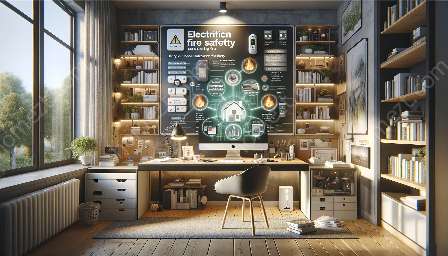Electricity is an essential part of modern homes, but it also presents potential hazards. Making sure that you and your family are aware of emergency procedures for electrical safety is crucial for protecting your home and loved ones. In this topic cluster, we will discuss the important aspects of electrical safety in the home, including emergency procedures, to enhance home safety and security.
Understanding the Risks
Before delving into emergency procedures, it's important to understand the risks associated with electrical hazards in the home. Electrical fires, shocks, and other accidents can occur as a result of faulty wiring, overloaded circuits, damaged appliances, or other electrical malfunctions. Being aware of these risks is the first step towards ensuring electrical safety.
Home Electrical Safety Measures
Prior to discussing emergency procedures, it's vital to implement home electrical safety measures to minimize the risk of an electrical incident. This includes ensuring that all electrical wiring and appliances are installed correctly and are up to code. Regularly checking for any signs of damage or wear and tear on electrical outlets, switches, and cords is also important.
Using ground fault circuit interrupters (GFCIs) in areas where water is present, such as kitchens and bathrooms, can help prevent electric shocks. Additionally, using surge protectors for sensitive electronic devices can safeguard against power surges. Educating all family members about the safe use of electrical appliances and avoiding overloading circuits can also contribute to home electrical safety.
Emergency Procedures for Electrical Safety
In the event of an electrical incident, knowing the appropriate emergency procedures can make a significant difference. It's crucial to act swiftly and effectively to minimize the risk of injury or property damage. Here are some key emergency procedures for electrical safety in the home:
1. Power Disconnection
If an electrical fire or shock occurs, the first step is to cut off the power source. This can be done by switching off the main circuit breaker in the electrical panel. It's important for all family members to know the location of the electrical panel and how to safely shut off the power in case of an emergency.
2. Fire Extinguishment
In the case of an electrical fire, using a fire extinguisher specifically designed for electrical fires can help contain the blaze. However, if the fire is spreading rapidly, evacuating the home and calling the fire department should be the top priority.
3. First Aid and Medical Attention
If someone experiences an electric shock, providing immediate first aid and seeking medical attention is essential. Cardiopulmonary resuscitation (CPR) may be necessary if the individual is not breathing or has no pulse. It's important to call for emergency medical help without delay.
4. Evacuation
If an electrical incident poses a significant risk, such as a widespread electrical fire or the presence of electrical hazards, evacuating the home and moving to a safe location is imperative. Having a designated meeting point outside the home can help ensure that all family members are safe and accounted for.
Preventive Maintenance and Training
Aside from being prepared for emergencies, preventive maintenance and ongoing training can enhance electrical safety in the home. Regularly inspecting electrical components, scheduling professional electrical inspections, and participating in electrical safety training programs can further reduce the likelihood of electrical incidents.
Conclusion
By being aware of the risks, implementing preventive measures, and knowing the appropriate emergency procedures, you can significantly improve electrical safety in your home. Proper education, preparation, and quick action in the event of an electrical emergency are essential for enhancing home safety and security.



















